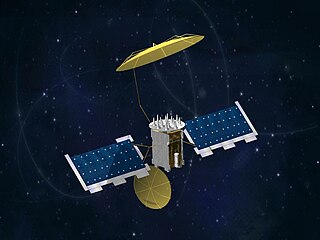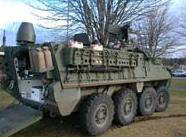The Ku band is the portion of the electromagnetic spectrum in the microwave range of frequencies from 12 to 18 gigahertz (GHz). The symbol is short for "K-under", because it is the lower part of the original NATO K band, which was split into three bands because of the presence of the atmospheric water vapor resonance peak at 22.24 GHz, (1.35 cm) which made the center unusable for long range transmission. In radar applications, it ranges from 12 to 18 GHz according to the formal definition of radar frequency band nomenclature in IEEE Standard 521-2002.

A very-small-aperture terminal (VSAT) is a two-way satellite ground station with a dish antenna that is smaller than 3.8 meters. The majority of VSAT antennas range from 75 cm to 1.2 m. Bit rates, in most cases, range from 4 kbit/s up to 16 Mbit/s. VSATs access satellites in geosynchronous orbit or geostationary orbit to relay data from small remote Earth stations (terminals) to other terminals or master Earth station "hubs".
The Ka band is a portion of the microwave part of the electromagnetic spectrum defined as frequencies in the range 26.5–40 gigahertz (GHz), i.e. wavelengths from slightly over one centimeter down to 7.5 millimeters. The band is called Ka, short for "K-above" because it is the upper part of the original NATO K band, which was split into three bands because of the presence of the atmospheric water vapor resonance peak at 22.24 GHz (1.35 cm), which made the center unusable for long range transmission. The 30/20 GHz band is used in communications satellite uplinks in either the 27.5 GHz and 31 GHz bands, and high-resolution, close-range targeting radars aboard military airplanes. Some frequencies in this radio band are used for vehicle speed detection by law enforcement. The Kepler Mission used this frequency range to downlink the scientific data collected by the space telescope.
Satellite Internet access is Internet access provided through communication satellites. Modern consumer grade satellite Internet service is typically provided to individual users through geostationary satellites that can offer relatively high data speeds, with newer satellites using Ku band to achieve downstream data speeds up to 506 Mbit/s. In addition, new satellite internet constellations are being developed in low-earth orbit to enable low-latency internet access from space.
A broadcast license is a type of spectrum license granting the licensee permission to use a portion of the radio frequency spectrum in a given geographical area for broadcasting purposes. The licenses generally include restrictions, which vary from band to band.

The Mobile User Objective System (MUOS) is a United States Space Force narrowband military communications satellite system that supports a worldwide, multi-service population of users in the ultra high frequency (UHF) band. The system provides increased communications capabilities to newer, smaller terminals while still supporting interoperability with legacy terminals. MUOS is designed to support users who require greater mobility, higher bit rates and improved operational availability. The MUOS was declared fully operational for use in 2019.

Satcom on the Move (SOTM), or satellite communications on the move, is a phrase used in the context of mobile satellite technology, specifically relating to military ground vehicles, Maritime and Airborne platforms. The basic principle behind Satcom On The Move is that a vehicle equipped with a satellite antenna is able to establish communication with a satellite and maintain that communication while the vehicle is moving.

The Wideband Global SATCOM system (WGS) is a high capacity United States Space Force satellite communications system planned for use in partnership by the United States Department of Defense (DoD), Canadian Department of National Defence (DND) and the Australian Department of Defence. The system is composed of the Space Segment satellites, the Terminal Segment users and the Control Segment operators.

USA-195, or Wideband Global SATCOM 1 (WGS-1) is a United States military communications satellite operated by the United States Air Force as part of the Wideband Global SATCOM programme. Launched in 2007, it was the first WGS satellite to reach orbit. It is stationed at a longitude of 174.8° East.
Radio over fiber (RoF) or RF over fiber (RFoF) refers to a technology whereby light is modulated by a radio frequency signal and transmitted over an optical fiber link. Main technical advantages of using fiber optical links are lower transmission losses and reduced sensitivity to noise and electromagnetic interference compared to all-electrical signal transmission.
SwiftBroadband is an IP-based packet-switched communications network that provides a symmetric ‘always-on’ data connection of up to 650 kbit/s per channel for aircraft globally except for the polar regions, using the Inmarsat satellite constellation.

USA-233, or Wideband Global SATCOM 4 (WGS-4) is a United States military communications satellite operated by the United States Air Force as part of the Wideband Global SATCOM programme, which was launched in 2012. The fourth Wideband Global SATCOM satellite, it is the first WGS Block II satellite to be launched. It is stationed at 88.5° East in geostationary orbit.

USA-204, or Wideband Global SATCOM 2 (WGS-2) is a United States military communications satellite which is operated by the United States Air Force as part of the Wideband Global SATCOM programme. Launched in 2009, it was the second WGS satellite to reach orbit, and operates in geostationary orbit at a longitude of 60° East.

USA-211, or Wideband Global SATCOM 3 (WGS-3) is a United States military communications satellite operated by the United States Air Force as part of the Wideband Global SATCOM programme. Launched in 2009, it was the third WGS satellite, and final Block I satellite, to reach orbit. It is stationed at 12° West in geostationary orbit.

USA-244, or Wideband Global SATCOM 6 (WGS-6) is a United States military communications satellite operated by the United States Air Force as part of the Wideband Global SATCOM programme. Launched in 2013, it was the sixth WGS satellite to reach orbit. It is stationed at a longitude of 135° West, in geostationary orbit. WGS-6 was procured by the Australian Defence Force for the U.S. Air Force, in exchange for participation in the programme.
X band or SHF Satellite Communication is widely used by military forces for beyond line of sight communications. X band is used because it provides a compromise between the characteristics of different frequency bands which is particularly suited to the needs of military users. The characteristics include interference and rain resilience, terminal size, data rates, remote coverage and whether it is reserved for governmental use.

A ground segment consists of all the ground-based elements of a space system used by operators and support personnel, as opposed to the space segment and user segment. The ground segment enables management of a spacecraft, and distribution of payload data and telemetry among interested parties on the ground. The primary elements of a ground segment are:

Global sat Group is a consortium of companies providing satellite communication services worldwide with headquarters located in the United States.
Honeywell's JetWave is a piece of satellite communications hardware produced by Honeywell that enables global in-flight Wi-Fi connectivity. Its Wi-Fi connectivity is provided using Inmarsat’s GX Aviation network. The JetWave is used in business and general aviation, as well as defense and commercial airline users.

USA-263, or Wideband Global SATCOM 7 (WGS-7) is a United States military communications satellite operated by the United States Air Force as part of the Wideband Global SATCOM programme. Launched in 2015, it was the seventh WGS satellite to reach orbit. It is stationed at a longitude of 135° West, in geostationary orbit. WGS-7 was procured by the United States Air Force.







